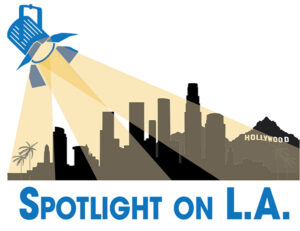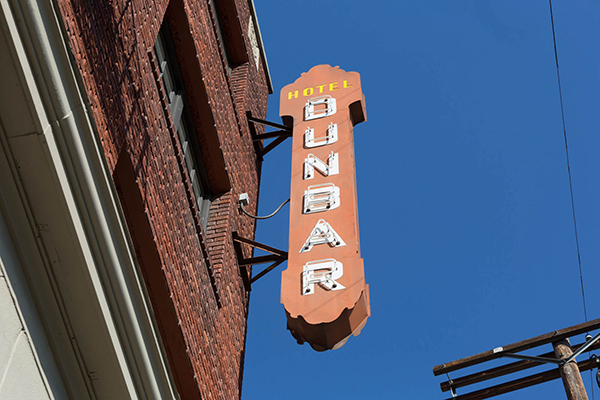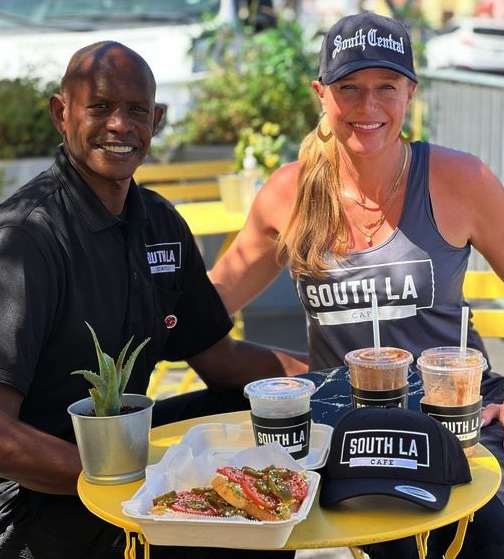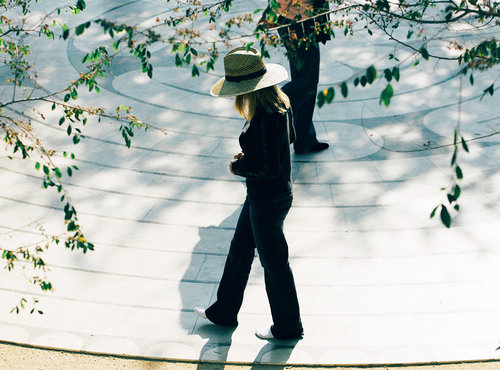
By Darlene Donloe
Contributing Writer
The old adage, “Nobody walks in L.A.” isn’t exactly true.
Angelenos and visitors alike regularly take part in Angels Walk LA, a self-guided urban walking tour of historical sites in and around Los Angeles.
Founded in 1996, Angels Walk LA, designed to enhance the pedestrian environment, includes 13 distinctive walks including Chinatown, Hollywood, Union Station, San Pedro, Bunker Hill, North Hollywood, Figueroa Corridor, Highland Park, Crenshaw, Boyle Heights, Wilshire, East Hollywood-Silver Lake and Central Avenue.
One of the more popular strolls, Angels Walk Central Avenue, officially opened with a ribbon-cutting ceremony on April 13, 2021, and was the last “walk” to be completed.
Filled with 15 different historical sites, Angels Walk Central Avenue is a 1.6 miles, two or three three-hour trek through a South L.A. neighborhood from Adams Boulevard to Vernon Avenue that from the 1920s through the 1940s, was considered the cultural, social and entrepreneurial heart of the Black community in Los Angeles.
“Angels Walk Central Avenue tells the story of a major thoroughfare regarded as a thriving hub of African-American art, culture and enterprise,” said Los Angeles City Councilman Curren Price, who represents the 9th District that includes that section of Central Avenue. “For many decades, Central Avenue was the heart and soul of the Black community in Los Angeles. The corridor was home to a wide variety of Black-owned small businesses including shops, restaurants, financial institutions, insurance services and entertainment venues.”
During the first half of the 20th century, Central Avenue, considered a multi-cultural multi-ethnic community, was a destination for world-class music and entertainment, as a principal neighborhood in the civil rights movement, and as the focal point of Black banking and enterprise.
“It was a neighborhood that largely developed out of the trials that came from housing restrictions and other injustices, but nevertheless thrived culturally and economically,” Price said.
Tracey Lane, former co-director of Angels Walk L.A. who is now a volunteer, said there are a number of important, “yet largely unknown stories” to tell about the neighborhood.
“Now they are accessible to everyone,” she said. “Our hope is that this walk serves to honor and remember those who built this community and inspire those who currently call Central Avenue home.”
Angels Walk Central Avenue, which shines a light on the importance and legacy of both the past and present of the South L.A. neighborhood, takes participants along its main corridor, past three Paul R. Williams-designed buildings: Second Baptist Church, the 28th Street YMCA, and Angelus Funeral Home in an effort to bring visitors to the places that celebrate Black neighborhoods and history.
Other highlights include the Hotel Dunbar (a celebrated jazz music destination), Lincoln Theater, the home of United Nation’s diplomat Ralph J. Bunche, publisher and activist Charlotta Bass, music impresario John Dolphin’s Dolphins of Hollywood, and L.A.’s first credentialed African American librarian Miriam Matthews.
A main attraction, of course, is information on the bustling jazz scene and the many clubs that lined the thoroughfare. Central Avenue, at one time economically vibrant and to this day culturally important, was the focal point of the West Coast jazz scene. The history of the street and the music that emanated from such jazz greats as Charles Mingus, Billie Holiday, Dexter Gordon, Ernie Andrews, Gerald Wilson and more, is now celebrated annually in District 9 with the Central Avenue Jazz Festival, set to take place this year on Sept. 23.
Along the way, participants can enjoy authentic Central American and Mexican cuisine and sweets from the 27th Street Bakery (owned by 1984 Olympic sprinter Jeanette Bolden).
The pamphlet for the self-guided tour features a 1940s census data map titled “Distribution of Negros” primarily focusing on Central Avenue.
“When it started in 1996, the walks were downtown proper,” Lane said. “The 13 walks have been developed over 20-something years. Back then walking wasn’t popular but Deanna Molloy (Angels Walk LA founder and board chair) had a vision for a walking environment.
“From the beginning, a team of people have been involved. The routes were collaborative. They were designed to take people past the key sites.”
Lane said neighborhood walks are determined through a number of factors including “historical significance.”
Some were predominantly sponsored by the Metropolitan Transportation Authority, she said.
“Some neighborhoods were included that were near public transit.”
For more than 25 years, Angels Walk LA has worked to preserve and highlight Los Angeles’ history while promoting pedestrian engagement and public transportation throughout the city.
The walks, a melting pot of L.A.’s various cultures, are designed to not only celebrate the history of the City of Angels but to bring the public face to face with some of the city’s historically and culturally rich locations.
While on the various walks, which average about 2.5 miles, participants can utilize a guidebook available in either print or PDF format, along with historic on-sidewalk stanchions to discover the various stories that have shaped the city.
“The heart of the walks is to introduce the city to its residents and educate them about the important things in our history,” said Lane, a fourth-generation Angeleno. “This amazing city that we live in. It’s a way for visitors to see the city as well. The heart was to help Angelenos know their city — the places, people, history and events.”
Lane said the walks are sure to reveal previously unknown people and places of interest.
“From East Hollywood to Boyle Heights, to Central Avenue, there are unexpected architectural treasures and cultural history there,” she said.
Guidebooks can be found in public tourist locations including the information desk at Union Station, the Hollywood & Highland Visitor’s Center, and the InterContinental Los Angeles Downtown Hotel.
A number of branches of the Los Angeles Public Library and Los Angeles County libraries also stock current guides.
It’s Lane’s hope that everyone takes an Angels Walk.
“When you get to know your city and other neighborhoods, it gives you a deeper appreciation of your neighbor,” she said. “This is a young city. Knowing where you come from is important for preservation. We don’t want to forget the people who have contributed. When you document history and experience it, it gives you an appreciation. L.A. is a place with a lot of different people. It’s important to know where we come from and how we fit together.”
Angels Walk LA is a nonprofit public benefit corporation working in association with the city of Los Angeles and the Metropolitan Transportation Authority to develop self-guided walking trails throughout the historically rich neighborhoods of Los Angeles.
“Spotlight on L.A.” is a Wave feature profiling little known places within the city.
Darlene Donloe is a freelance reporter for Wave Newspapers who covers South Los Angeles. She can be reached at ddonloe@gmail.com.












